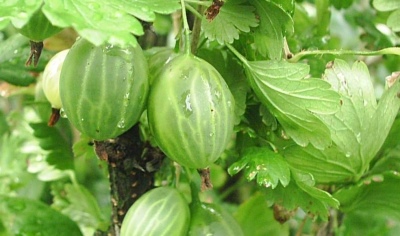
- Name synonyms: Bottle green, Brazilian
- Growth type: vigorous
- Description of the bush: medium spreading
- Escapes: Numerous, strong, of medium thickness, with hanging tops; the growing parts of the annual shoot are brown-red, in the rest of the green, almost glabrous
- Thorns: single, long, strong, directed downward; no spines
- Sheet: large, green, wrinkled, with sharpened blades
- Flowers: large, yellowish-white petals, greenish sepals with purple-red spots
- Berry size: large
- Berry weight, g: up to 16
- Berry shape: oblong-oval and pear-shaped
Bottle gooseberries are one of the most popular varieties with green berries. The harvested fruits are highly marketable, suitable for fresh consumption, processing into juices and wines, preserves, jam. The variety is also known under the names Brazilian, Green bottle.
Description of the variety
Gooseberry bushes are formed vigorously, medium spreading. There are many shoots, they are strong, of medium thickness, with curved tips directed towards the ground. Annual shoots are easy to distinguish by the brown-red tint of the bark, more mature ones are green in color. The surface of the branches is covered with single long thorns. The leaves in the crown are large, wrinkled, green, with pronounced lobes, acquire a brown tint in autumn.
Characteristics of berries
This gooseberry variety has large fruits weighing up to 16 g, of an unusual oblong-oval or pear-shaped shape. The berries are dark green with veins and red-brown dots on the surface. The skin is thinner at the tip and denser at the petiole. The pulp is colored green.
Taste qualities
The berries are refreshing, pleasant, sweet and sour, with a good balance of flavors. They are perfect for making desserts, salads, add a spicy note to sauces.
Ripening and fruiting
The variety belongs to the late, begins to bear fruit from the 2nd decade of July. The harvest is given annually. Fruits enter consumer maturity in the 1st decade of August.
Yield
For this indicator, the variety deserves a high rating. Up to 20 kg of berries are harvested from the bush.
Landing
This gooseberry is recommended for planting in fertile soils, with exposure to the sun or in partial shade. Plants are transferred in spring, in March-April, as well as in autumn, from the end of September, but no later than 1 month before the start of frost. According to agronomists, the second option is preferable, since young bushes have time to acclimatize and take root. When selecting a site, it is important to find a place where groundwater is no closer than 1.5 m from the soil surface. The best soils for this gooseberry are loam, sandy loam, not waterlogged, with an acidity of about 6.0 pH.
When planting between the bushes, it leaves 2 m each. At the selected points, pits up to 50 cm deep and with the same diameter are formed. The excavated soil is improved by mixing with 100 g of wood ash and superphosphate, 40 g of potassium sulfide and a bucket of humus. This mixture fills the hole, but not to the very top. A seedling is placed inside so that the root collar is 50 mm below the soil level, then everything is filled up to the very top, it is slightly compacted.

Growing and care
Proper care can affect the general condition of plants, their yield.The first watering is carried out immediately after planting. Enough 10 liters introduced into the root zone. Then you need to loosen and weed the trunk circle weekly, checking at the same time the soil moisture. If a clod of earth crumbles in your hand, it's time to water the plants.
Loosening should be quite deep, about 70 mm. If the soil is heavy, clayey, it is dug up with a pitchfork or a shovel. It will be enough to process the sand with a rake.
The bushes are fed twice. The first time after flowering, then at the end of the harvest. Gooseberry responds well to fertilization with a complex of compost, superphosphate, potassium chloride and nitrate.
The large and lush crown of this shrub can cause a lot of problems for inexperienced summer residents. It is recommended to support it with special bush holders. At the same time, formative pruning is performed for 3 years. It is carried out in the spring, before the awakening of the kidneys. The skeletal backbone is created by removing the excess shoot length up to 5 buds; only a few of the strongest branches are preserved from the root shoots.



Disease and pest resistance
Bushes are extremely rarely affected by American powdery mildew. Against pests, it will be useful to treat plants with boiling water from a watering can over dormant buds, immediately after the snow begins to melt in spring.

In order for the gooseberry to produce a good harvest, it is necessary to devote time to disease prevention.
Resistance to adverse climatic conditions
Bottle gooseberry has good winter hardiness. Without shelter, it can withstand a drop in atmospheric temperatures down to -25 degrees. It is drought-resistant, but it can reduce fruiting in the absence of watering for a long time.

Review overview
Gardeners give high marks to the Bottle variety. It is considered one of the largest-fruited, with a balanced taste and consistently high yield. The bushes are fast-growing, easily take root in a new place, they can be propagated by layering and cuttings, dividing, rejuvenating old plants. This gooseberry is planted everywhere, according to summer residents, it almost does not suffer from frost, only occasionally it is necessary to remove damaged branches. Plants also tolerate drought normally, but they can shed berries during a prolonged period of heat, and in wet weather the fruits begin to crack.



































































